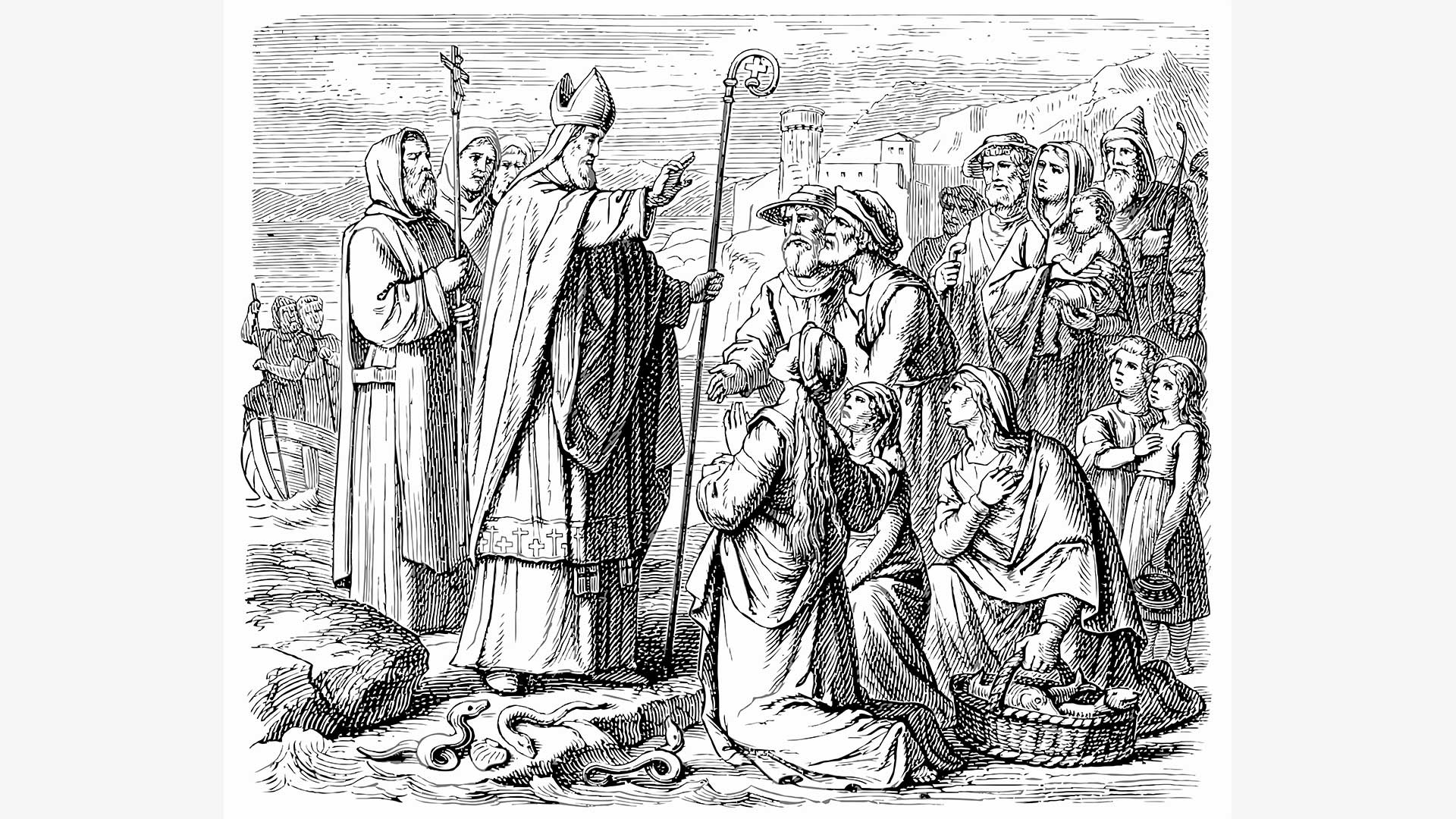Saint Patrick – Patron Saint of Ireland and Northern Ireland

Who Was St. Patrick?
St. Patrick was a fifth century Romano-British Christian missionary, and Bishop of Ireland. He is the national apostle (patron saint) of the Republic of Ireland and also of Northern Ireland.
Despite his status as (one of) the patron saints of Ireland not a lot is known about him and what we do know is gleaned from his own writings or from reports written long after his death. The other two patron saints of Ireland are Brigit of Kildare and Columba.
Click here for biographies on each of the UK’s patron saints and here for a calendar of UK patron saints days.
St. Patrick’s Early Life
St. Patrick was not born in Ireland.
The widely held belief is that he was born in the North of England or Southern Scotland in the latter part of the 4th century. Patrick was not his birth name either. It is believed to be Maewyn Succat.
There are dissident voices who assert that Patrick is actually of Gaulish (French Celt) descent – a claim that seems to be supported by something he himself wrote in his Confessions, namely:
“My father was Calpurnius, a deacon, son of Potitus, a priest of the town Bonavem Taberniae. He had near the town a small villa, Enon, where I became a captive.” The town Bonavem Taberniae has been identified by scholars as Boulogne.”
So there we have it. St. Patrick was either born in the North of England, Scotland or the North of France depending which theory one believes.
The only thing we know about his early life was that he was taken captive by a band of marauders and transported to Ireland. His Confessions tell us that he believed he was taken because he and his fellow captives had, “quite drawn away from God, we did not keep his precepts, nor were we obedient to our priests who used to remind us of our salvation. And the Lord brought down on us the fury of his being and scattered us among many nations, even to the ends of the earth, where I, in my smallness, am now to be found among foreigners.”
He was held as a slave for some six years in a location thought to be Armagh in Northern Ireland. In those days the slaving trade was endemic and raiding parties were common – presumably the then pagan Irish pirates knew that rich pickings could be made from Roman towns. The fact that he was taken captive and transported by sea to Ireland, lends credence to the idea that he was born and lived in Boulogne sur Mer and not Northern England/Scotland, as the UK locations are not near enough to a coast for a raiding party to make a quick escape by sea.
Patrick wrote (again in his Confessions) that it was during his six years in captivity he turned to God and heard a voice telling him he would soon go home and then that his ship was ready. He broke free from his captors and travelled some distance to a port. He then spent three days at sea before landing and “walking 28 days in uninhabited country”.
Basic geography again seems to point towards Northern France as his home as if he were heading home to Northern Britain he would surely have taken the short route across the Irish sea to either the Mull of Kintyre or Stranraer, each only around 10 miles away from Armagh.
In France (or Gaul as it was then known), irrespective of whether it was his birthplace or not, Patrick entered a monastery headed by St. Germain, the bishop of Auxerre. It was during his time in training that he adopted the Romano Christian name we know him by to this day, Patricius.
St. Patrick’s Later Life
Patrick spent twelve years training in various monasteries and realised his true vocation was as a missionary and to convert the pagans of Ireland to the true faith.
Much of the available information about this period of his life is confusing, even contradictory. Some report him living in England during this time and others suggest he was in Gaul (France). The only thing that seems to be backed by fact is that it was from the monastery in Auxerre (France) that the first Bishop of Ireland, Palladius (also a saint), was despatched to begin the conversion of the pagan Irish. Patrick also trained at Auxerre and had had a vision of being called back to Ireland. Whether he acted on this vision during Palladius’ tenure as Bishop of Ireland cannot be confirmed (or denied).
Palladius and his four companions were not warmly welcomed by the Irish and within two years he and two of his men transferred to Scotland.
This was Patrick’s opportunity to fulfil his vision. He was created Bishop by Pope Celestine in the year 432 and set off to Ireland possibly landing in Wicklow. He, like Palladius before him, was not welcomed by the majority of the people, who practiced a Celtic polytheism led by Druids. Nevertheless, Patrick travelled extensively across Ireland establishing monasteries, churches, schools, and nunneries, much to the distaste of the resident Druids who had him arrested on several occasions.
What about the often touted claim that St Patrick “banished all the snakes from Ireland”? This comes from “Life of the Saint”, written by Jocelyn of Furness late in the twelfth century. There have never been serpents in Ireland.
Allegedly aged 122 when he died on March 17th, he is thought to be buried at Down Cathedral in Downpatrick, County Down, alongside St. Brigid and St. Columba, although there is no conclusive evidence to support this.
Why Was St. Patrick Made a Saint?
Patrick was never formally canonised by a pope. In the early Catholic church, soon after the death of people considered very holy the local Church affirmed that they could be liturgically celebrated as saints. Lack of papal acceptance notwithstanding, St. Patrick is widely venerated by the Irish both at home and wherever Irish people ultimately migrated.
Is St. Patrick’s Day a Bank (Public) Holiday?
Yes and no!
In the United Kingdom, only Northern Ireland has a bank holiday for St. Patrick’s Day and it is on 17th March. If it falls on a weekend the following Monday is taken as the holiday.
The Republic of Ireland designates St Patrick’s day as a public holiday, the equivalent of a UK bank holiday.
Two other places in the world also recognise St Patrick’s day as a national holiday: the tiny Caribbean island of Montserrat and the Canadian province of Newfoundland and Labrador. Both locations were founded by Irish immigrants.
